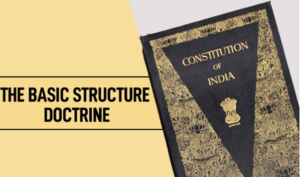Let’s debate Basic Structure.
Relevance
- GS Paper 2 Constitution of India —historical underpinnings, evolution, features, amendments, significant provisions and basic structure.
- Separation of powers between various organs dispute redressal mechanisms and institutions.
- Tags: #basicstructure #keshavnandbharti #india #ranjangogai #delhi #currentaffairs #upsc
Why in the News?
In his maiden speech while defending the Delhi Services Bill in the Rajya Sabha, the former Chief Justice, and a nominated member of the Rajya Sabha.
In the realm of democratic nations, does the right to shape the present and determine the future come unhindered by external “universal” values?
The question arises again with Ranjan Gogoi’s assertion that the “Basic Structure Doctrine” lacks a solid jurisprudential foundation, reigniting a debate reminiscent of the passionate 1951 discussions on the First Amendment of the Constitution.
Questioning Partisanship and Censorship
Scrutinizing the characterization of Ranjan Gogoi’s inaugural Rajya Sabha speech as “partisan” warrants careful consideration. Such censorious labeling stifles discourse regarding the Constitution’s effective operation.
Union Executive vs. Delhi Government: A Federal Balance Issue
- At the core of the Rajya Sabha debate lies the Union executive’s authority, through Parliament, to limit Delhi Government’s service power.
- The potential violation of the federal balance, integral to the Basic Structure Doctrine, raises concerns over the Bill’s alignment with judicial norms.
- Although the Bill passed with majority support, its legitimacy remains tainted by perceptions of constitutional impropriety.
Consequences for Democracy: Shrinking Executive Capacity
- As instances of constitutional impropriety accumulate, the executive’s power is constricted, hindering effective governance.
- This leads to a paradoxical situation where strong electoral mandates yield unfulfillable promises due to the executive’s constrained authority.
Link to Jammu and Kashmir Reorganization
- Given the present Indian political landscape, the gravity of this issue cannot be overstated. The impending hearings on Article 370’s abrogation and the Jammu and Kashmir Reorganisation Act of 2019 underscore the need to address essential questions.
- These questions encompass the practical importance of specific fundamental rights, the possibility of amending these rights, and the authority governing their application.
Key Questions for Indian Democracy
- Fundamental Rights in Practice: The extent of fundamental rights and their potential amendments.
- Final Word on Rights Application: Who holds authority over the interpretation and application of these rights.
Tracing Back to 1951: The First Amendment and Article 21
- Reflecting back to 1951, when the First Amendment was debated, it becomes clear that the Constitution prioritized “procedure established by law” over “due process.” Article 21 and Article 368 were introduced to align state and society through incremental amendments, acknowledging the need for change without inhibiting core principles.
Emergence of Basic Structure Doctrine: Kesavananda Bharati Case
- The Basic Structure Doctrine, originating from the Kesavananda Bharati judgment in 1973, asserts that the basic structure of the Constitution cannot be altered through amendments.
- Although the doctrine doesn’t provide an exhaustive list, it is an essential yardstick for judicial review.
Political Dynamics and Democracy’s Resilience
- India’s political framework, featuring a vigilant judiciary and an empowered legislature, upholds the separation of powers.
- This dynamic system fosters democratic resilience and adaptation, ensuring the state’s capacity to withstand societal and historical pressures.
Necessity of Open Debate: Countering “Cancel Culture”
In today’s acrimonious atmosphere, the importance of open debates centered on facts and logic cannot be overstated. Upholding Pandit Nehru’s vision, the “cancel culture” that stifles discourse impedes justice and democratic consolidation.
Basic Structure Doctrine as a Guiding Star
- Chief Justice DY Chandrachud aptly likened the Basic Structure Doctrine to the “Pole Star” of Indian politics.
- Just as a competent navigator relies on this guiding star in stormy weather, the doctrine offers direction in complex political scenarios.
The call for dialogue and discourse, rather than divisiveness, is essential for the strength and vitality of Indian democracy. With the looming storm of challenges, it’s crucial to heed Nehru’s wisdom and ensure that the soul of the nation finds articulate expression through robust debate.
The evolution of the Basic Structure doctrine can be traced from the issue of the right to property and the first constitutional amendment act of 1951.
|
Sources: The Hindu
Mains Question
The “Basic Structure Doctrine” has been a subject of profound debate and analysis in the context of Indian democracy. Discuss the origins, significance, and challenges associated with this doctrine, highlighting its impact on the delicate balance of power and its role in safeguarding fundamental rights.




